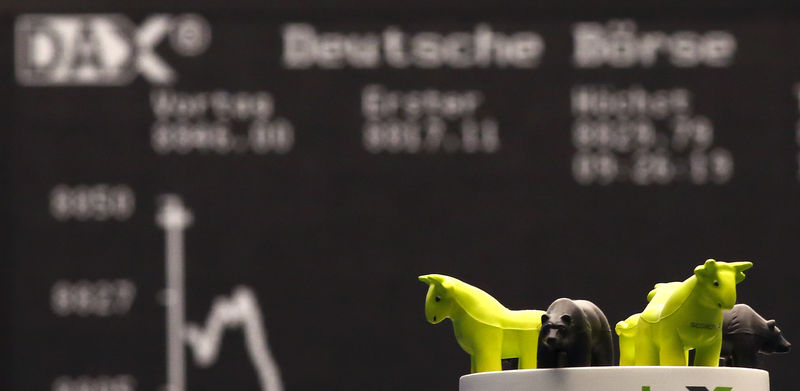(Bloomberg) --
Pandemic trading will go down in history for its breathtaking velocity: The fastest market crash meets the swiftest rescue package to offset a virus infecting the world at a pace unseen this century.
A Wall Street fixated on the speed of new coronavirus cases is now turning its attention to the next phase of the crisis: How quickly the lockdowns end.
Bad data is a given. Weak earnings are expected. Stimulus is priced.
Whatever shape the economic recovery takes, cross-asset strategies are hinging on how fast consumption and investment returns.
“Everyone was talking about six to nine months as a timeline for lockdown,” said Edward Park, deputy chief investment officer at Brooks Macdonald Asset Management. “Now people are talking about restrictions being lifted in the next one to two months. That shortening of the timeline means that the dire economic data that we have seen can be looked through.”
Look no further than the economic data crossing the tape on Thursday. Gauges of private-sector activity in Europe were disastrous, beyond already gloomy expectations. Yet after an initial dip the Stoxx Europe 600 Index of equities quickly found its feet.
The pattern may be similar when jobless claims hit in the U.S. later -- the S&P 500 has risen every Thursday for the past four weeks even as applications for unemployment benefits in America surged by more than 20 million.
Read more: Wall Street Turns a Blind Eye to Catastrophic U.S. Economic Data
It’s not that the data doesn’t matter. But the scale of the central bank and fiscal response has been so huge, it’s helped investors see past the pain so far. And now, just as the relentless bad figures threatened to overwhelm their optimism -- witness the chaos in the oil market -- the largest economies are moving toward re-opening.
Germany this week allowed smaller stores to reopen in some locations, becoming the first in Europe to move toward a cautious revival of business activity. The White House on Friday issued guidelines for states to reopen in phases, with some already moving toward easing restrictions.
“We do look at PMIs and initial jobless claims to understand the depth of recession, but it’s not the key input to determine our asset allocations,” said Thushka Maharaj, global multi-asset strategist at JPMorgan (NYSE:JPM) Asset Management. The team is focused on the removal of restrictions.
“We’ll be tracking higher-frequency measures of infection rates, movement of people back to work. Maybe electricity consumption, transportation,” said Maharaj.
The S&P 500 closed last week at the highest in more than a month, even though the Trump administration’s plans leave many questions unanswered.
Countries adopted varying measures at different times to contain the pandemic, and as a result have experienced different outcomes in terms of spread. It’s likely they will therefore have contrasting approaches to ending their lockdowns, which will feed into relative market performance.
“A pattern seems to be emerging that the euro zone countries which experienced the sharpest impact on public (and economic) life will be the last countries exiting the lockdown measures,” ING Bank NV economists including Bert Colijn wrote this week. “Add to this significant differences across countries regarding the size of the fiscal reaction and there is a clear risk of an asymmetric recovery.”
Both virus rates and asset moves already speak to this. While Germany, with 150,000 cases but just 5,000 deaths, already eased some restrictions, Italy has almost 190,000 confirmed infections and 25,000 deaths, and won’t start relaxing containment measures until May 4.
That helps to account for why the benchmark Italian stock index lags the German equivalent by some 7 percentage points this year. The spread between debt yields of the two nations has widened by more than 80 basis points.
Meanwhile, the world has yet to fully understand the Covid-19 virus. If easing restrictions lead to an acceleration in infections or deaths, containment measures could make a swift return.
At Deutsche Bank AG (DE:DBKGn), strategists including Jim Reid have been diving into the micro details of what lockdown exit strategies might look like across geographies. They highlight that many countries want to reopen a little sooner than expected, indicating an acceptance “they will have to live with the virus in some form -- at least for now.”
“A key consideration is how to deal with the second wave of the virus that is likely from increased activity,” they wrote in a note. “This is being weighed up against the increasing awareness of the health problems associated with isolation and lockdown itself.”
All this will play out over some time. Until then investors conditioned to bad news and data appear receptive to glimmers of light.
“As long as things are gradually improving and moving on a timeline where the lockdown isn’t going to continue for the next year, if things are gradually improving at a slow pace, that’s enough for equities,” said Park at Brooks Macdonald.
©2020 Bloomberg L.P.
